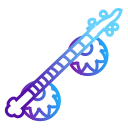DOTARA
Type: TAT VADYA
Dotara is a stringed instrument made of wood, metal, and lizard skin. This folk instrument is found in Assam. A plucked instrument, it is majorly used by the folk and traditional singers of ‘Goalpara’ and ‘Kamrup’ districts of Assam.
DOTARA in Assam
Material: Wood, lizard skin, metal
A plucked instrument with Cylindrical wooden body. A lizard skin covered bowl shaped resonator, long neck, and a round peg box. Four strings, plucked by a plectrum with right hand whereas the strings are stopped by left hand fingers. Used by the folk and traditional singers of ‘Goalpara’ and ‘Kamrup’ districts of Assam.
DOTARA in West Bengal
Material: Metal, Cotton, Timber, Brass, Silk, Horn, Bone, Wood
The Dotara, literally meaning “two-stringed”, is also a folk musical instrument that resembles a guitar or a mandolin, or the long necked two-stringed lute found in Central Asia. The Dotara dates back to the fifteenth or sixteenth century, and despite its name, may have more than two strings, often four, five or six. There are two varieties of Dotara – the Bangla form that originated in the Rahr Bengal region, which has metal strings, and the Bhawaiya, made of thick cotton strings, which gives it a bass timbre. The Dotara can produce drones, rhythmic adjuncts and also melodies, and was possibly devised in the course of the development of a sense of melody. Like the Ektara, the Dotara is also made by stretching leather on a hollowed wooden frame. Strings made of brass, or twisted silk strands, are attached to the base of the frame at one end, and to the pegs at the top. The pegs are used to tighten or loosen the strings, which are known as the jil,sur, vam and gam. The wooden top of the Dotara is decorated with engravings, usually of birds. The Kati or plectrum is made up of horn, bone or wood.
 Government of India
Government of India


































 Recognizing the ongoing need to position itself for the digital future, Indian Culture is an initiative by the Ministry of Culture. A platform that hosts data of cultural relevance from various repositories and institutions all over India.
Recognizing the ongoing need to position itself for the digital future, Indian Culture is an initiative by the Ministry of Culture. A platform that hosts data of cultural relevance from various repositories and institutions all over India.

